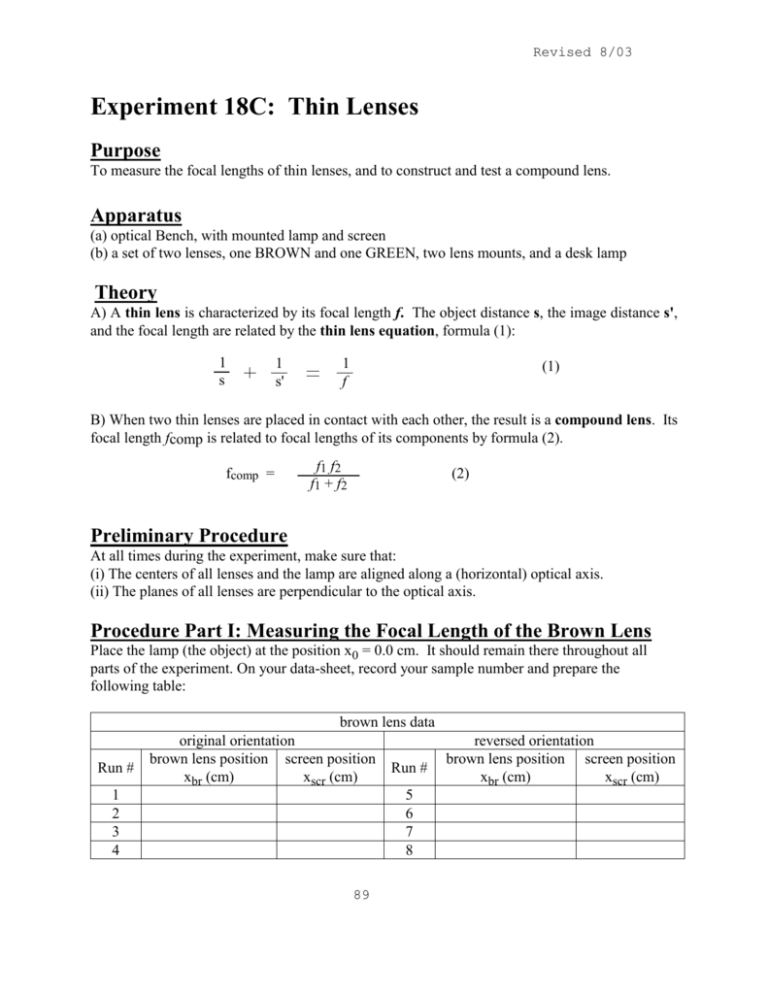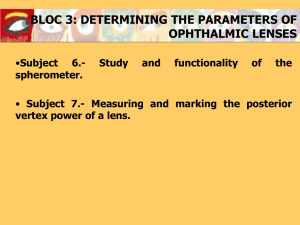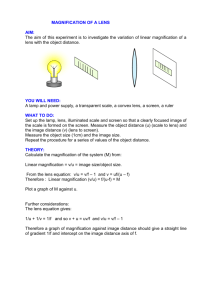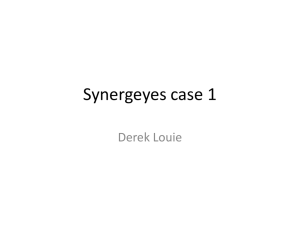Experiment 1-Z Units of Measurement
advertisement

Revised 8/03 Experiment 18C: Thin Lenses Purpose To measure the focal lengths of thin lenses, and to construct and test a compound lens. Apparatus (a) optical Bench, with mounted lamp and screen (b) a set of two lenses, one BROWN and one GREEN, two lens mounts, and a desk lamp Theory A) A thin lens is characterized by its focal length f. The object distance s, the image distance s', and the focal length are related by the thin lens equation, formula (1): 1 s 1 s' 1 f (1) B) When two thin lenses are placed in contact with each other, the result is a compound lens. Its focal length fcomp is related to focal lengths of its components by formula (2). fcomp = f1 f2 f1 + f2 (2) Preliminary Procedure At all times during the experiment, make sure that: (i) The centers of all lenses and the lamp are aligned along a (horizontal) optical axis. (ii) The planes of all lenses are perpendicular to the optical axis. Procedure Part I: Measuring the Focal Length of the Brown Lens Place the lamp (the object) at the position x0 = 0.0 cm. It should remain there throughout all parts of the experiment. On your data-sheet, record your sample number and prepare the following table: brown lens data Run # original orientation brown lens position screen position xbr (cm) xscr (cm) 1 2 3 4 Run # 5 6 7 8 89 reversed orientation brown lens position screen position xbr (cm) xscr (cm) Experiment 18C lamp (object) brown lens screen (image) incident light rays optical axis xscr xbr x0 s' s Fig. 1 Optical Bench Setup for Part 1 c) Place the brown lens about 21-23 cm from the lamp and record its position to within 1 mm accuracy, as xbr, under Run #1. Place the screen beyond the lens (See Fig. 1.) and move it backand-forth until you observe a focused image. Ask your instructor if in doubt. Record the screen position (the image) as xscr under Run #1. d) Repeat (c) three more times, with xbr ranging from about 19 cm to about 30cm, spaced evenly. Record xbr and the corresponding xscr for each run in the table. e) Reverse the brown lens in its orientation by rotating the shaft through 180º. Make four runs as before, placing the lens between 19 and 30 cm but with different values of xbr. Record xbr and the corresponding xscr for each run in the table. f) Optional (consult your Instructor): Make a direct measurement of fbr by focusing a far-away object on the screen. Make two such measurements, one of them in reversed position, and find their average value. 90 Experiment 18C Procedure Part II: Measuring the Focal Length of the Green Lens (g) Prepare on your data sheet a table for the green lens, similar to that under (b) for the brown lens. (h) Place the green lens about 20-22cm from the lamp and perform (c). Record xgr and xscr under Run #1. (j) Repeat (h) three more times, with xgr ranging between 18 and 28 cm, evenly spaced, and record the corresponding xscr. (k) Reverse the green lens in its orientation, as in (e). Make four runs, with different values of xgr and record the corresponding xscr. (l) Optional (Consult your Instructor): Repeat (f) for the green lens. Procedure Part III: The Compound Lens (m) Your brown and green lenses can be combined into a compound lens. Press your lenses together as shown in Fig. 2 - it will make no difference which one of the two you will reverse. Mount them carefully in a single holder. There is no need to "paste" them together. brown lens compound lens green lens Fig. 2 Constructing the Compound Lens (n) On your data sheet, prepare a table for the compound lens similar to those for the brown and green lenses. Now repeat the entire procedure. Start with the compound lens at about 12 cm and work between 10 and 20 cm, including the reversal of lenses, for a total of 8 runs. 91 Experiment 18C Lab Report Part I: The brown lens 1) Solve equation (1) for f and display the result. Next, express s and s' in terms of x br and xscr with the help of Fig. 1. Note that in your situation x0 is zero. From all this deduce by algebra formula (3), as shown: fbr = (xscr – xbr) xbr (3) xscr 2) Calculate fbr for each of your runs and display your results in Table I, finding the averages for original and reversed orientations separately. Then proceed to calculate the average: <fbr> = (<f1> + <f2>) / 2 TABLE I. Brown Leans Results Original Orientation Run # 1 2 3 4 Reversed Orientation fbr AVE<f1> Run # 5 6 7 8 fbr AVE<f2> Question #1: If your values of <f1> and <f2> differ by more than 0.5 cm, state the likely reason. 2a) If you have done item (f) (direct measurement of fbr), then find the average for both orientations and compare it with the result under (2). Comment on your result. Part II: The green lens 3) Calculate fgr for each of your runs and proceed as in (2). Display your results in Table II (similar to Table I). Calculate <fgr>. Question # 2: Is formula (3) still useful for calculating fgr? Explain. 3a) If you have done item (l), proceed as in (2a) above. Part III: The Compound Lens 4) Construct Table III and proceed as in (2) or (3) above, obtaining <fcomp>. 5) Calculate the theoretical value of the focal distance of the compound lens by formula (2) and display the %-difference between the theoretical and experimental values. Question #3: Was it really necessary to reverse the compound lens? Explain your answer. 92








